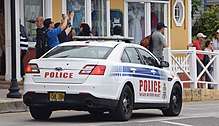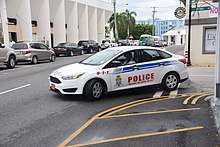Royal Cayman Islands Police Service
The Royal Cayman Islands Police Service is the standing police force of the British overseas territory of the Cayman Islands. The police force was formed in 1907 and currently (2009) stands at 343 enlisted officers, with 64 civilians.
| Royal Cayman Islands Police Service | |
|---|---|
| Abbreviation | RCIPS |
| Agency overview | |
| Formed | 1907 |
| Employees | 407 |
| Jurisdictional structure | |
| Operations jurisdiction | Cayman Islands, CAY |
 | |
| Map of Royal Cayman Islands Police Service's jurisdiction. | |
| Size | 102 square miles |
| Population | 68,076 |
| Operational structure | |
| Headquarters | George Town |
| Sworn members | 343 |
| Agency executive |
|
| Facilities | |
| Stations | 7 |
| Website | |
| http://www.rcips.ky | |
The Royal Cayman Islands Police Service serves all three of the Cayman Islands, namely, Grand Cayman, Cayman Brac and Little Cayman. Demographically, in 2018, the estimated population of the Cayman Islands was about 68,076 representing a mix of more than 100 nationalities. The vast majority of people reside on Grand Cayman with Cayman Brac being the second most populated with about 2,000 residents, followed by Little Cayman with around 200 permanent residents.
Against this backdrop the RCIPS deals with more than 22,000 calls for assistance every year, as well as proactively patrolling the streets 24-hours a day, seven days a week. It has a history of actively recruiting police officers from other nations with at least five years' experience.[1][2]
Structure and ranks
The RCIPS is headed by a Commissioner, assisted by up to two Deputy Commissioners. Other executive officers hold the ranks of Chief Superintendent and Superintendent. Each of the four policing Districts is headed by a Chief Inspector, assisted by an Inspector (except in the smallest District, which covers the two smaller islands). Inspectors are responsible for neighbourhood teams consisting of Sergeants and Constables.[3] In addition to neighbourhood policing, officers are assigned to the Criminal Investigation Department (CID) with ranks (up to Chief Superintendent) prefixed with the word 'Detective'. There are also a number of specialist units.
The RCIPS engages Special Constables (“Specials”), who are unpaid volunteer police officers, to support the work of full-time officers.[4] There are powers to appoint Auxiliary Constables to specialist roles. Special Constables may advance to the rank of Special Sergeant, and also have their own Commandant, with a Deputy and an Assistant.[5]
The prefix “detective” is given to officers who are assigned to the CID, after completing the necessary selection and training process. Detective ranks run parallel to uniformed ranks, and range from Detective Constable to Detective Superintendent.[6]
List of Ranks
- Commissioner
- Deputy Commissioner
- Superintendent
- Chief Inspector
- Inspector
- Sergeant
- Constable
Training
- Recruit
Other
- Auxiliary Constable and Special Constable
Police Districts

For purposes of criminal investigation, neighbourhood policing, and crime prevention, the RCIPS is divided into four Districts:
- West Bay, with one police station at West Bay.
- George Town, with one police station at George Town (Elgin Avenue).
- Eastern District, with three police stations at East End, Bodden Town, and North Side.
- Cayman Brac and Little Cayman, with two police stations, one on each island.
In addition to the Elgin Avenue police station in George Town, several other operational police bases exist in the town, including the national police headquarters in Shedden Road, the traffic policing unit in Lindhurst Avenue, and administrative offices on Walkers Road.

Specialist departments
The RCIPS has a number of specialist departments, beyond the CID and the neighbourhood policing teams. Of these, the most visible and sizeable are the following.
Air Operations Unit
The Air Operations Unit (AOU) provides aerial support for border security, search and rescue, police operations, and disaster response. The AOU has a uniformed civilian Executive Officer, and is staffed by professional pilots and engineers, as well as police officers, led by a sergeant. The AOU was founded in 2010, and equipped with a Eurocopter EC135 police helicopter. This original aircraft was withdrawn after a failure in service in February 2019.
The AOU now operates two Airbus H-145 helicopters (formerly the Eurocopter EC-145), acquired in a special deal with the United Kingdom in late March 2019,[7] and early December 2019.[8]
Joint Marine Unit
Policing at sea is a significant part of law enforcement for an island nation. The JMU is a combined force of police officers and Cayman Islands Customs Department officers operating a fleet of fast motor boats to provide law enforcement, customs control, immigration control, and search and rescue operations.
Uniform Support Group
The USG is a paramilitary force within the RCIPS, whose officers are trained to high standards of fitness, and to an advanced level of firearms training. The USG provides operational support as required, and is also the frontline of defence against organised violent crime and terrorism threats.
Equipment
The Royal Cayman Islands Police Service is an unarmed police force. [9]
References
- This article outlines recruitment from Jamaica, and mentions several other nations.
- Report in the Guardian newspaper of a British police officer relocating to the Cayman Islands.
- Basic operational structure, and rank table, may be found here on the RCIPS official website.
- The Special Constabulary has its own website, here.
- The rank structure is shown here.
- https://www.rcips.ky/about
- https://www.rcips.ky/new-police-helicopter-the-airbus-h145-arrives-at-rcips-air-operations-unit
- https://www.caymaniantimes.ky/news/new-rcips-helicopter-arrives-on-island
- "Information About Cayman Islands Police - Royal Cayman Islands Police Service". www.rcips.ky. Retrieved 9 July 2020.

.svg.png)